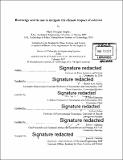| dc.contributor.advisor | Steven R.H. Barrett. | en_US |
| dc.contributor.author | Staples, Mark Douglas | en_US |
| dc.contributor.other | Massachusetts Institute of Technology. Engineering Systems Division. | en_US |
| dc.date.accessioned | 2017-05-11T19:58:43Z | |
| dc.date.available | 2017-05-11T19:58:43Z | |
| dc.date.copyright | 2016 | en_US |
| dc.date.issued | 2017 | en_US |
| dc.identifier.uri | http://hdl.handle.net/1721.1/108975 | |
| dc.description | Thesis: Ph. D. in Engineering Systems, Massachusetts Institute of Technology, School of Engineering, Institute for Data, Systems, and Society, February 2017. | en_US |
| dc.description | "February 2017." Cataloged from PDF version of thesis. | en_US |
| dc.description | Includes bibliographical references (pages 150-169). | en_US |
| dc.description.abstract | The use of modern bioenergy presents an opportunity to mitigate CO2 emissions contributing to anthropogenic climate change by offsetting fossil fuel use, and the work presented in this thesis contributes to the literature on bioenergy and climate change mitigation in three areas. First, this thesis quantifies the maximum potential reduction in global lifecycle greenhouse gas (GHG) emissions from the use of bioenergy to offset demand for fossil fuel-derived electricity, heat and liquid fuels in 2050. The findings indicate that bioenergy could reduce annual emissions from these end-uses by a maximum of 4.9-38.7 Gt CO2e, or 9-68%. The range of results reflects different assumptions defining potential bioenergy availability, and fossil fuel demand that could by offset by bioenergy, in 2050. In general, assumptions leading to greater calculated bioenergy availability, and fossil fuel demand, correspond to larger reductions in anthropogenic GHG emissions. In addition, offsetting fossil fuel-fired electricity and heat with bioenergy is found to be 1.6-3.9 times more effective for emissions mitigation than offsetting fossil fuel-derived liquid fuel, on average. At the same time, liquid fuels make up 18-49% of global final bioenergy in the scenarios considered for 2050, demonstrating that a mix of bioenergy end-uses maximizes lifecycle emissions reductions. The analysis also finds that GHG emissions reductions are maximized by limiting deployment of total available primary bioenergy to 29-91%, showing that lifecycle emissions including land use change (LUC) are a constraint on the usefulness of bioenergy for mitigating global climate change. Next, this thesis quantifies the environmental and economic performance of fermentation and advanced fermentation (AF) technologies for the production of renewable middle distillate (MD) fuels, including jet and diesel, in terms of lifecycle GHG emissions and minimum selling price (MSP). The attributional lifecycle GHG emissions of AF MD derived from sugarcane, corn grain and switchgrass are found to range from -27.0 to 19.7, 47.5 to 117.5, and 11.7 to 89.8 gCO2e/MJMD, respectively, compared to 90.0 gCO2e/MJMD for conventional petroleum-derived MD. These results are most sensitive to the co-product allocation method used, the efficiency and utility requirements of feedstock-to-fuel conversion, and the co-generation technology employed. The MSP of MD fuel produced from sugarcane, corn grain and switchgrass AF is also calculated as a range from 0.61 to 2.63, 0.84 to 3.65, and 1.09 to 6.30 USD20l2 /literMD. For comparison, the price of MD fuel was 0.80 USD2O2/literMD when this analysis was initially carried out in 2013, and was $0.38 USD2O2/literMD at the time of writing. This analysis demonstrates that improvements in overall feedstock-to-fuel conversion efficiency, for example from more efficient sugar extraction, enzymatic hydrolysis, or metabolic conversion processes, could lead to reductions in both the lifecycle GHG emissions and MSP of AF MD fuels. The final contribution of this thesis is a dynamic cost-benefit assessment (CBA) of a policy of large-scale alternative jet (AJ) fuel adoption, in terms of the societal climate damages and fuel production costs attributable to aviation. A system dynamics model is developed to capture time- and path-dependence of the environmental and economic performance of AJ technologies, as well as potential non-linearities and feedbacks associated with their adoption. The analysis finds that the large-scale use of AJ could result in a reduction in the net present value (NPV) of the societal costs of aviation, in terms of climate damages and fuel costs. However, even for the most promising feedstock-to-fuel production pathways considered, a net reduction in the societal costs of aviation has a probability of less than 50% if the initial societal opportunity cost of AJ feedstock exceeds 140 USD2015 /tfeedstock, or if land use change (LUC) emissions associated with incremental feedstock demand exceed 4.2 tCO2/inc. feedstock. These results highlight the potential importance of waste- and residue-derived AJ for reducing the societal costs of aviation, as these feedstocks represent a lower risk of LUC emissions and potentially lower societal opportunity costs than commodity crops. | en_US |
| dc.description.statementofresponsibility | by Mark Douglas Staples. | en_US |
| dc.format.extent | 169 pages | en_US |
| dc.language.iso | eng | en_US |
| dc.publisher | Massachusetts Institute of Technology | en_US |
| dc.rights | MIT theses are protected by copyright. They may be viewed, downloaded, or printed from this source but further reproduction or distribution in any format is prohibited without written permission. | en_US |
| dc.rights.uri | http://dspace.mit.edu/handle/1721.1/7582 | en_US |
| dc.subject | Institute for Data, Systems, and Society. | en_US |
| dc.subject | Engineering Systems Division. | en_US |
| dc.title | Bioenergy and its use to mitigate the climate impact of aviation | en_US |
| dc.type | Thesis | en_US |
| dc.description.degree | Ph. D. in Engineering Systems | en_US |
| dc.contributor.department | Massachusetts Institute of Technology. Engineering Systems Division | |
| dc.contributor.department | Massachusetts Institute of Technology. Institute for Data, Systems, and Society | |
| dc.identifier.oclc | 986497368 | en_US |
